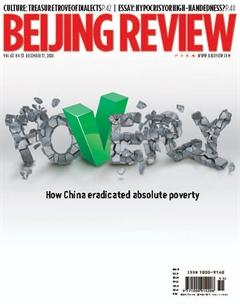AN INSPIRING VICTORY
In the process of eradicating absolute poverty in China, 750 million people have risen out of destitution since 1978. According to World Bank data, Chinas poverty alleviation success means a reduction of more than 70 percent in global poverty. Some foreign diplomats to China share their views on the achievement:
Teshome Toga, Ethiopian Ambassador
Thats a huge task that requires a lot of work, good investment and policy strategy as well as very strong and dedicated leadership.
My colleagues who visited the areas most affected by poverty [in China] and saw the poverty alleviation efforts were very impressed. We in Ethiopia would also like to lift our people out of poverty.
We have about 20 million poor. What China did gives us hope and encourages us. It is a source of inspiration and we believe we can also do it.
We also aspire to have a better life for our people, so there are definitely experiences wed like to learn and see how each village was identified, and experts and officials were assigned and given a certain timeframe and the necessary resources, and then the target was finally achieved. Thats meticulous planning in my view. Every country has its own conditions, but there are certain things we can learn.
My colleagues and I were concerned as to whether the coronavirus pandemic would affect this poverty alleviation target, but the government of China kept its word with determination and commitment. They deserve our appreciation.
James Kimonyo, Rwandan Ambassador
Chinas success to uplift millions of people from poverty within this short period of time is commendable and many countries can learn from what China has done.
I think the approach China took is what economists or social workers call the multidimensional poverty index, because poverty cannot be described based on just someones income or where he or she lives. There are a number of things that are required for people to be considered out of poverty, and the lack of which would make them poor.
The approach China used looked at those dimensions. How about education? Do our children have access to education? Not only education but quality education? Do people have better places to live in? Do they have access to an effective healthcare system?
When you begin to address those critical issues facing people, then youre essentially addressing poverty issues and therefore, reducing poverty. From what I know so far in China and from reading a number of materials, including the book by President Xi Jinping, Up and Out of Poverty, apart from looking at it from that wider, broader perspective, there is another important approach that China used—targeted measures.
You dont have an umbrella project for an entire community, but rather look at those who are critically affected by some of these issues I just mentioned. The Communist Party of China (CPC) and the government looked at people who were in dire need in terms of access to education, healthcare and housing.
We visited some of the places and saw how people moved out of extremely terrible type of housing to better housing. That gave them a chance to engage in other economic activities. If you dont [have a multidimensional approach] then you run the risk of addressing one issue and leaving others unaddressed and your efforts to reduce poverty may not be successful.
Bakhtiyor Saidov, Uzbek Ambassador
The main thing is that the fight against poverty is a priority for the government, and the policy to eradicate it is carried out systematically.
The funds deployed in the anti-poverty campaign cover several areas, including rural infrastructure financing, agricultural subsidies and soft loans. The broad purpose is to promote self-development and empower the poor, not to provide gifts from the government.
If in previous decades the main way was to move the poor from rural areas to new cities, where jobs were created for them as well as social infrastructure, including hospitals, schools and kindergartens, now everything is aimed at providing additional income sources to those who remain in the villages and are not covered by industrial agriculture.
I also highly appreciate the policy that encourages businesses to invest in poverty-relief development projects. Mass entrepreneurship and innovation brought additional market elements to the campaign, offering rural residents incentives and loans for self-employment and setting up small businesses.
In addition, the role of the Internet in helping people in need, providing them with jobs and opportunities in education and health, as well as facilitating the sale of agricultural products via e-commerce should be noted.
Studying Chinas experience, I saw many similarities with the poverty reduction program implemented in Uzbekistan, particularly, the measures aimed at training the population in professions, improving financial literacy, encouraging people to engage in entrepreneurship, improving infrastructure and the quality of education and medical services, introducing targeted benefit systems and ensuring the rights and interests of women and children.

